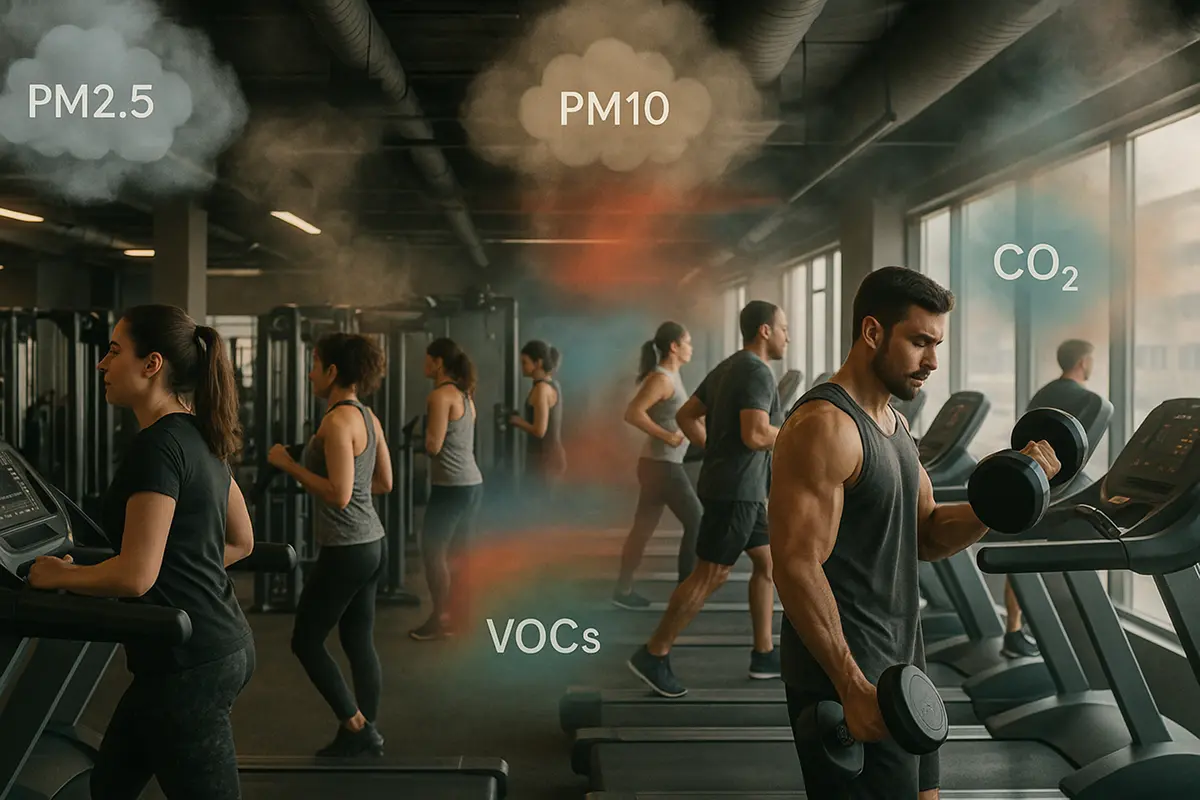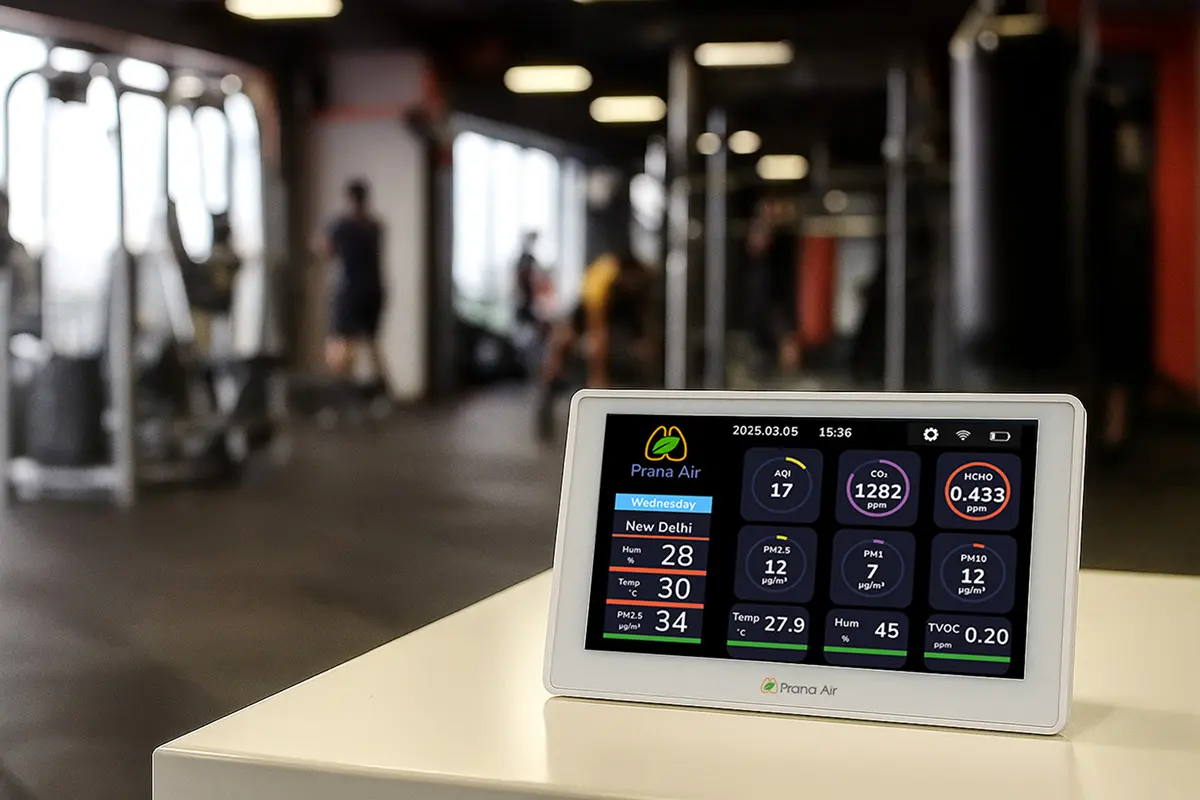You hit the gym to become stronger, healthier, and more focused. Literally, it becomes your escape from deadlines, screens, and stress. For many of us, the gym is more than a routine, as it’s a ritual. A place where we sweat, push limits, and rebuild ourselves, one rep at a time. But what if, while working to improve your health, something silent and invisible was working against it? Yes, and it could be the air you are breathing, the indoor air quality in gyms!
We focus on the weights, the reps, the form, but have you ever thought about the air you are breathing with each rep? We rarely think about the most important element of all: the air we breathe while we train. In reality, indoor air quality (IAQ) in gyms can have a huge impact on how we perform, recover, and even how we feel after a session.
This blog dives into the unseen risk hiding in many fitness centres—polluted indoor air—and how solutions can help gyms take control, protect their members, and truly support the fitness journey from the inside out.
Why Clean Air in the Gym Is as Important as Clean Weights?
When you exercise, your body kicks into high gear. Your heart pumps faster, your muscles demand fuel, and most importantly, your lungs work overtime. At rest, you might breathe in around 6 to 8 litres of air per minute. But during a workout, that number can surge to 50–100 litres per minute, depending on how hard you’re pushing yourself.

Now imagine this: you’re breathing deeper, faster, and more frequently—pulling in more air than at any other time of your day. But what if that air is polluted?
In a tightly enclosed space like a gym, where dozens of people are sweating, exhaling, and moving, the air can quickly fill with invisible contaminants like PM2.5 particles, carbon dioxide (CO₂), and volatile organic compounds (VOCs). And because your lungs are wide open during exercise, you’re absorbing far more of these harmful substances with every breath.
It’s not just air because every time you move your body, it provides fuel to your body. And if that fuel is polluted, it’s not just your performance that suffers, it’s your health.
What’s Polluting the Air in Your Gym?
Most people assume that air pollution is only an outdoor issue. However, the indoor air quality in fitness centres can be worse than the streets outside, especially in urban areas.
Let’s break down a few of the most common pollutants found in gyms and how they affect your health:

1. PM2.5 and PM10 (Fine Particulate Matter)
These microscopic particles come from dust, sweat, friction between machines, and even human movement. In poorly ventilated gyms, they can accumulate quickly, entering deep into the lungs and leading to respiratory issues, inflammation, and fatigue.
2. Carbon Dioxide (CO₂)
Gyms often have high occupancy rates, especially during peak hours. When many people are exhaling in a confined space with insufficient ventilation, CO₂ levels can spike above 2,000 ppm. This leads to drowsiness, reduced oxygen intake, and poor performance.
3. Volatile Organic Compounds (VOCs)
These come from cleaning products, rubber mats, disinfectants, and paint. While often ignored, VOCs can cause dizziness, nausea, headaches, and long-term respiratory problems if exposure is frequent.
4. Humidity and Mold
Gyms with poor ventilation also struggle with humidity. High moisture levels can lead to mold growth, which irritates the respiratory system and increases the risk of allergies and infections.
What the Data Tells Us About Air Pollution in Gym?
Scientific studies and real-world monitoring back up the concerns:
- Research published in Environmental Science & Technology highlights that PM2.5 levels in fitness centers can vary widely—from as low as 5 μg/m³ to peaks of 777 μg/m³, with some gyms consistently averaging between 170 and 500 μg/m³, far exceeding safe air quality standards.
- Another study recorded indoor CO₂ levels surpassing 2,500 ppm during peak workout hours in closed gym studios.
- A survey conducted in India revealed that over 60% of gyms do not monitor indoor air quality, and nearly 75% lack sufficient ventilation systems.
These findings are not just numbers—they highlight how gym air pollution is a real and present threat to health, performance, and safety.
How Poor Air Quality in Gyms Affects Your Workout and Health?
The effects of poor air quality in gyms go beyond temporary discomfort. Some of the most common—and dangerous—impacts include:
- Decreased oxygen intake, leading to faster fatigue and reduced endurance
- Headaches, dizziness, and brain fog due to elevated CO₂
- Respiratory irritation and coughing, especially during cardio sessions
- Weakened immune function from prolonged exposure to indoor pollutants
- Worsening of asthma and allergies, triggered by fine dust or mold spores
Many gym-goers experience these symptoms but attribute them to stress or dehydration. The real culprit may be the air itself.
A Smarter Solution: Prana Air’s Real-Time Gym Air Quality Monitoring
Recognizing a problem is only the first step—solving it is what truly makes a difference. That’s where Prana Air comes in.

Prana Air provides advanced indoor air quality monitors designed for public spaces like gyms, yoga studios, and fitness centres. These smart devices help gym owners and operators track real-time data on pollutants and respond quickly when air quality drops below healthy levels.
Here’s Sensible+, the best indoor air quality monitor by Prana Air it works:
- The monitor continuously measures PM2.5, PM10, CO₂, VOCs, humidity, and temperature.
- Data is displayed in real-time on the monitor screen, a digital dashboard, accessible on mobile or desktop.
- Alerts are triggered when pollution levels go above acceptable thresholds.
- Based on the data, gym staff can adjust ventilation systems or activate purifiers.
The result? Cleaner air, better workouts, and safer members.
Gyms that have implemented Prana Air’s solutions have reported fewer complaints related to fatigue or dizziness, better workout efficiency among clients, and improved member satisfaction.
What Gym Owners and Members Can Do?
For gym owners, investing in an air quality monitoring solution is no longer optional—it’s essential. Not only does it protect the health of your clients, but it also enhances your reputation as a modern, health-conscious facility.
For gym-goers, it’s important to be aware. If you regularly feel tired, lightheaded, or unwell during your workouts, don’t just blame yourself. Ask if your gym monitors indoor air quality. If not, recommend that they consider a solution like Prana Air.
You deserve clean air, especially when your body is working its hardest.
Conclusion: Your Health Is More Than Just Fitness
We go to the gym to become stronger, healthier, and more energised. But if the air we breathe is filled with harmful pollutants, we’re unknowingly sabotaging our own efforts.
Air quality in gyms is not just a maintenance issue—it’s a vital part of the fitness journey. With the help of real-time air monitoring by Prana Air, gyms can become truly healthy spaces that support every rep, every breath, and every goal.
Your body works hard. Make sure the air you breathe in the gym works just as hard for you.